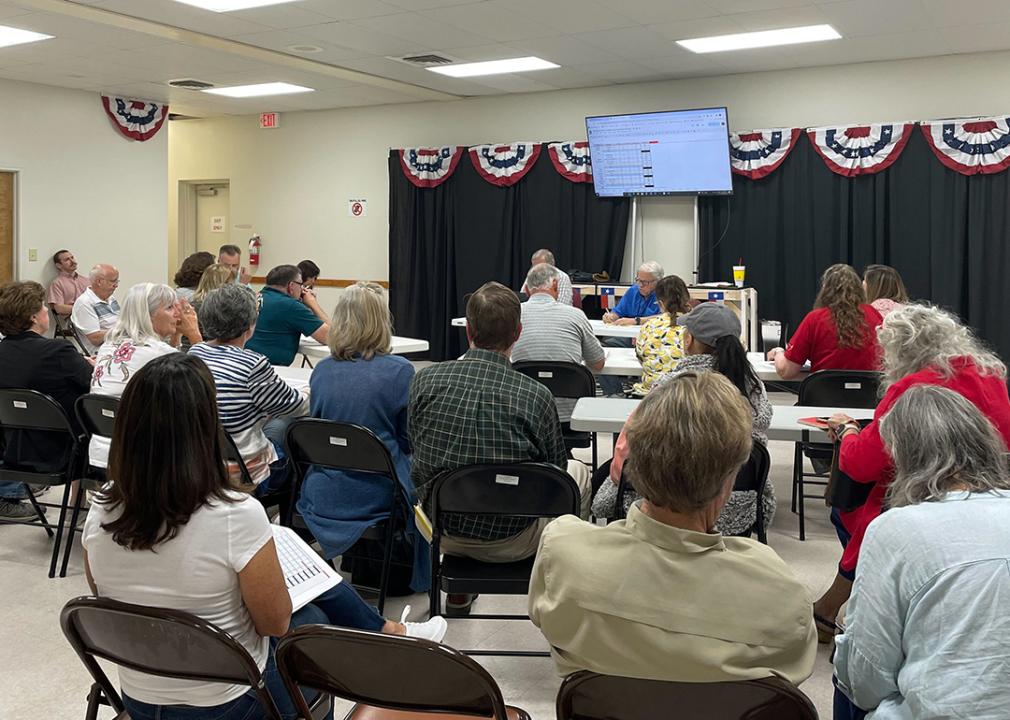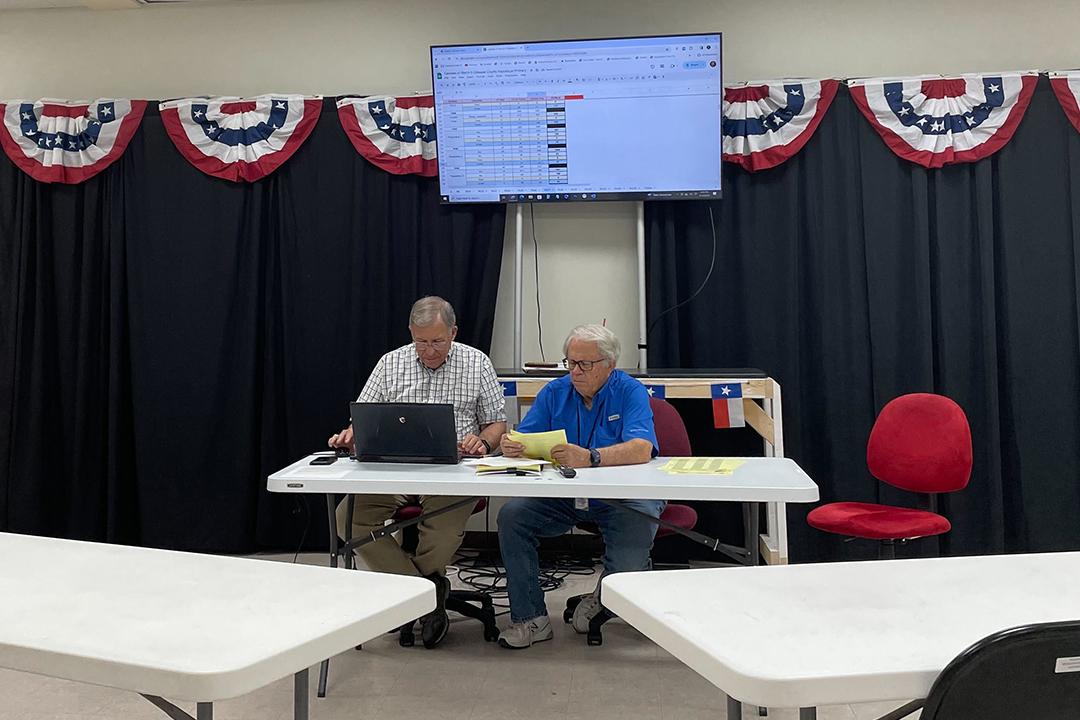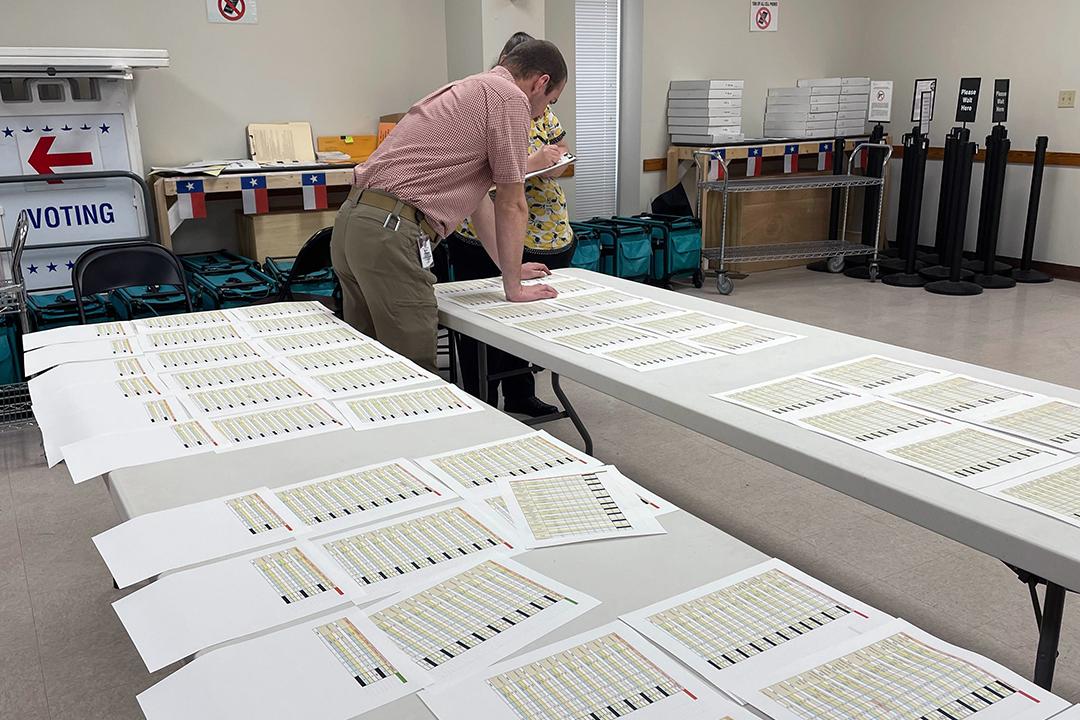Texas county's GOP officials declared election hand-count a success, but kept finding errors

Natalia Contreras for Votebeat
Texas county’s GOP officials declared election hand-count a success, but kept finding errors
County judges and election workers gather in a full room for the Republican canvass of the primary election.
An hour after Gillespie County Republican Party Chairman Bruce Campbell declared the hand-counted primary election results completely accurate and certified them as final, he found another discrepancy.
“It’s my mistake for not catching that,” he said, sitting in front of his laptop inside the Gillespie County election administration office on March 14. “I can’t believe I did that.”
The late catch meant that Campbell had to ask the early voting ballot board chair, who had already left and lives 30 minutes away, to return to the elections offices, figure out how the error happened, and fix it.
According to a report by Votebeat, the election was a low-profile party primary, but stakes are high. Gillespie County Republicans, led by Campbell, decided months ago to hand-count more than 8,000 ballots. Experts agree and studies show the method is time-consuming, costly, less accurate, and less secure than using machines, but local Republicans, citing unsupported concerns about the accuracy of voting machines, were determined to try and show otherwise. Workers recruited and trained by the party counted until the early hours of the next morning, and declared the effort a success. Proponents of hand-counting are now touting Gillespie as a model.
But the county party had to fix a series of errors in the results reported from almost every precinct between the election and the canvass on March 14, though none of the discrepancies changed the outcome of a race. Travis County Republicans, who hand-counted some ballots as well, also had to fix discrepancies in their tally.
Texas requires partial recounts only for ballots that are tabulated electronically — there is no provision in state law to require the local GOP to recount these ballots or audit the results of the hand count. The Texas Secretary of State’s election division does not have the authority to audit the election unless Gillespie is one of the counties the office randomly selects for an audit.
At least one precinct judge acknowledged mistakes were made during the count but said they were caught and corrected that night. Campbell, pictured below, left, said he has full confidence that the tallying of the votes was accurate, and the party will not voluntarily conduct an audit or recount to verify the results.
![]()

Natalia Contreras for Votebeat
All of the numbers didn’t add up
Bruce Campbell and Jim Riley sitting at a table reviewing precinct vote totals.
But not everyone feels that way. Scott Netherland, the election judge for Precinct 6, turned in all of the necessary paperwork to the elections office just before midnight on election night, believing it all checked out. When he woke up the next day, he decided to double-check the results. He told Votebeat that 197 voters had cast ballots at his precinct on election day. For each race on the ballot, the total number of ballots cast should have totaled to 197, including, for example, instances when a voter skipped a race. But in one race, he’d reported only 160 votes. In another, 157. As he went down the list, he noticed he had 207 votes reported for a third race.
“My heart sank,” Netherland said. He’d miscounted the totals in seven separate races.
Netherland said he immediately contacted Campbell, then rushed to the elections office to review tally sheets. In doing so, he realized that multiple other precincts also had reported clearly inaccurate totals.
If he hadn’t done that, “we’d be still sitting on mistakes,” Netherland, who’s been working elections in Gillespie for more than a decade and did not support the hand count effort, told Votebeat.
Netherland said he still isn’t confident the election results are accurate, based on the errors that he and others have found. On March 14, Netherland said the Republican Party in Gillespie has introduced human error into the election process with the hand count.
“We took something that worked and now broke it,” Netherland said. “We failed to guard the purity of the election with this hand count. What we just did is evidence that this hand count was not accurate.”
Other Republicans continue to tout the effort as a success.
One of them was David Treibs, a member of the Fredericksburg Tea Party who helped lead the effort to hand count. In a video interview posted on a social media platform created by Mike Lindell — a well-known election conspiracy theorist and the CEO of bedding company MyPillow – Treibs acknowledged he’d made errors but said they weren’t a problem.
“So there were two ballots, and I just didn’t add them up. So I would have had to add 450 and two, and it would have been 452 and I didn’t. I just forgot to fill it in,” Treibs said in the video posted just after the election. “So I don’t really think that’s something that’s going to shut down the election and it’s like, ‘oh my gosh, he didn’t add 450 and two and come up with 452 and now that means the whole election was a failure.’ Well, that’s ridiculous.”
A long weekend reconciling errors
For his part, Campbell said he spent all weekend before the canvass going over tally sheets and double-checking vote totals on documents called precinct return sheets — reconciliation forms that election workers fill out with the number of votes cast for each race on election day. He repeatedly found errors. All but one of the county’s 13 Republican precincts had reported incorrect totals on the official reconciliation forms.
Campbell, by Texas law, is in charge of the GOP primary election in the county and responsible for attesting that the results are correct. He said he put together a spreadsheet with all the numbers from each precinct and each race. He consulted with the Secretary of State’s Office and local election officials. He highlighted the errors he found in red and sent the spreadsheet around to the precinct judges, telling them they needed to correct the errors at the canvass.
On March 14, during the election canvass — the official examination of votes cast in an election — all of the precinct judges, who supervised each polling place, gathered at the election office to correct their errors. One by one, they called out the correct totals.
According to the precinct return sheets from election night obtained by Votebeat, Precinct 2 and Precinct 6 — Netherland’s precinct — had the most errors with inaccurate vote totals reported in seven races. Precinct 12 reported errors in vote totals for six races. Precinct 9 was the only one with no reported errors.
Some judges quickly explained how errors happened during the canvass, reasons ranging from “poor penmanship” that was hard to read, to accidentally writing the wrong numbers, or miscalculations.
The short public meeting lasted around 30 minutes. After their mistakes were resolved and results were certified, some clapped and said, “We did it!” Soon after, all the precinct judges except for one went home. Campbell and the Gillespie County elections staff stayed behind to begin manually entering the official results into the state’s reporting system.
That’s when Campbell found yet another error, forcing him to call the early voting ballot board chair back to the elections office for another round of correction.
After that, entering the results in the state system posed yet another challenge. When ballots are scanned using voting equipment and software, a report of the totals is created in the same format the state uses. The state requires those results be manually entered, separated by candidate and proposition totals for the day of the election, early voting, and mail ballots. But in his spreadsheet, Campbell only had those totals broken out by candidate and propositions per precinct.

Natalia Contreras for Votebeat
Data entry errors found at this stage of the counting
Elections staff surrounded by ballots reviewing precinct totals.
Elections staff printed out the spreadsheets, laid them out across four tables, and read the totals out loud, adding them up with a calculator so they would be aggregated in the format the state requires, and then manually entered them into a computer.
This process took nearly three hours because they caught themselves making new data entry errors as they were reading the newly aggregated totals out loud and writing them down before entering them into the state system.
In Travis County, where Republicans hand-counted more than 1,000 mail-in ballots on the day of the election, there were also discrepancies. In an email, Travis County Republican Party Chair Matt Mackowiak said that in the race for U.S. House District 35, undervotes were inaccurately reported as overvotes. An undervote is an instance when a voter appears not to have marked as many choices as they’re allowed to in a given race; an overvote is an instance when a voter selected too many choices in a given race. After resolving the errors, the party is “confident now” that the results are accurate.
Experts say these mistakes raise more questions about the accuracy of the vote tallies that can’t be answered without an audit or a recount.
“This 100% is indicative that we know mistakes are going to happen every single time. And I don’t know how anybody would feel confident, after that many errors were identified, that all their errors had been identified,” said Jennifer Morrell, a former election official and an expert on election audits. Morrell is the CEO of the Elections Group, an elections consulting firm.
“The only way I can think to validate what they claim are the final vote counts is to run all those ballots through a voting system and compare the two outcomes.”
Morrell added that the discrepancies found in Gillespie and in Travis don’t typically occur in elections where voting equipment is used. Even in parts of the process where hand counting is used, such as audits or recounts (where only one or two races are counted rather than the entire ballot), “we find that it’s easy for people to make mistakes,” she said. And that’s especially true when tallying undervotes.
In Gillespie, the Republican Party has no intention of doing any sort of recount, Campbell said. Neither do Travis County Republicans, Mackowiak said.
Campbell stressed that each hand-counting team had a caller of the votes, a watcher to ensure the caller was correct, and three people writing down the totals. “If it didn’t match, they’d have to go back and count again,” he said. “You have three people. Three of them are not going to make the same error.”
Campbell said a committee was created by the party to study the hand count. The committee will survey every person who participated.
On the primary election night, Joy Smith, the Precinct 4 judge, was the last to bring election results to the county’s elections office. It was Smith’s first time as the precinct’s supervisor. On March 14, she also had to fix an error. When writing the total number of votes for a proposition on the ballot, Smith wrote the number 451. It should have been 415. “I literally just switched the two numbers when I wrote it down on the form,” she said, something she attributed to exhaustion in the wee hours of the morning after a long night.
Smith said the hand count made election day as a first-time election judge more difficult. “There were a lot of extra forms that we had to fill out that day, double check the tally sheets,” Smith said. “There’s just a lot more on your plate. But I am not giving up. I’m going to keep helping.”
This story was produced by Votebeat and reviewed and distributed by Stacker Media.





